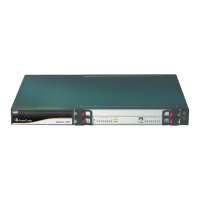Version 7.0 343 Mediant 3000
User's Manual 18. Control Network
Parameter Description
Message Policy
[SIPInterface_MessageP
olicyName]
Assigns a SIP message policy to the SIP interface.
For configuring SIP Message Policy rules, see ''Configuring SIP Message
Policy Rules''.
Used By Routing Server
[SIPInterface_UsedByRo
utingServer]
Enables the SIP Interface to be used by a third-party routing server for
call routing decisions.
[0] Not Used (default)
[1] Used
For more information on the third-party routing server feature, see
Centralized Third-Party Routing Server on page 284.
18.4 Configuring IP Groups
The IP Group table lets you configure up to 33 IP Groups. An IP Group represents a SIP
entity in the network with which the device communicates. This can be a server (e.g., IP
PBX or ITSP) or a group of users (e.g., LAN IP phones). For servers, the IP Group is
typically used to define the server's IP address by associating it with a Proxy Set (see
Configuring Proxy Sets on page 355).
You can use IP Groups for the following:
SBC application: Classification of incoming SIP dialog-initiating requests (e.g., INVITE
messages) to IP Groups based on Proxy Set. If the source address of the incoming
SIP dialog is defined for a Proxy Set, the device assigns ("bonds") the SIP dialog to
the IP Group associated with the Proxy Set. The feature is configured using the IP
Group table's 'Classify by Proxy Set' parameter. For more information and
recommended security guidelines, see the parameter's description, later in this
section.
SBC application: Representing the source and destination of the call in IP-to-IP
Routing rules (see Configuring SBC IP-to-IP Routing Rules on page
603).
SIP dialog registration and authentication (digest user/password) of specific IP Groups
(Served IP Group, e.g., corporate IP-PBX) with other IP Groups (Serving IP Group,
e.g., ITSP). This is configured in the Account table (see ''Configuring Registration
Accounts'' on page
363).
Gateway application: Call routing rules:
• Tel-to-IP calls: The IP Group is used as the destination of the outgoing IP call and
is used in Tel-to-IP call routing rules (see Configuring Tel-to-IP Routing Rules on
page 496).
• IP-to-Tel calls: The IP Group identifies the source of the IP call and is used in IP-
to-Tel call routing rules (see Configuring IP-to-Trunk Group Routing Rules on
page 505).
• Number manipulation: The IP Group can be associated with a number
manipulation rule (see Configuring Number Manipulation Tables on page 469).
Included in routing decisions by a third-party routing server. If deemed necessary for
routing, the routing server can even create an IP Group. For more information, see
Centralized Third-Party Routing Server on page
284.

